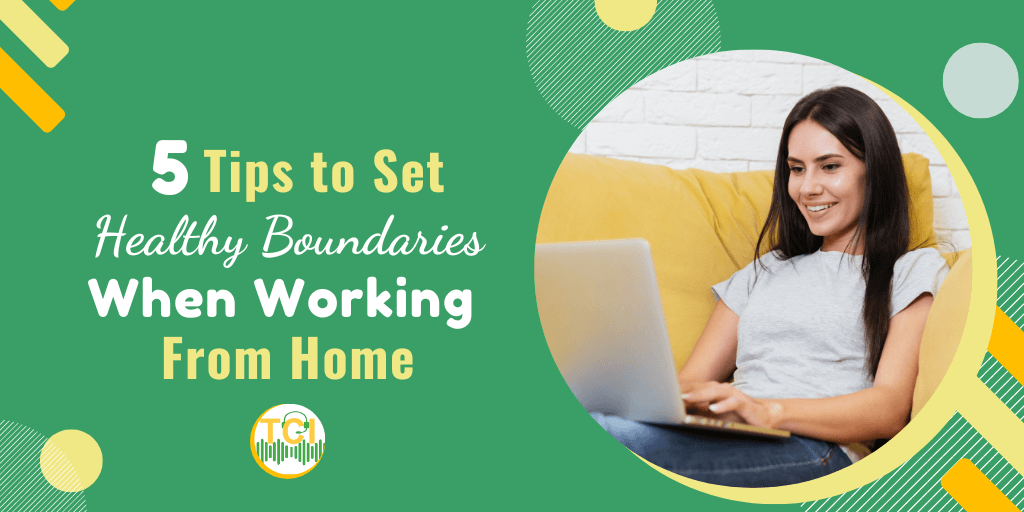⏳ New Year Sale Live — 40% OFF All Courses with code NY40 | See Pricing | Enroll Now

Working from home — that’s the dream, right?
Americans are certainly welcoming it. In a recent McKinsey report, 87% of US workers said they embraced working remotely when offered the opportunity, and 58% work from home at least one day a week.
But for many, taking work home has also meant letting it take over their personal lives. More than half of virtual or work-from-home employees reported working more hours than when they were in the office, and almost half of the hybrid workers have felt burnt out in the past year.
Unless you want to be shackled to your laptop, you need to set healthy boundaries when working from home. Here are five tips on how to be a kinder manager of your own time and resources.
Working from home can make you paranoid.
You’re on your own most of the time, so it’s easy to feel like you’re not doing enough. You might start working longer hours to compensate for that feeling or refuse to log off for the evening until you “feel done.”
Rather than bully yourself into overdrive, set yourself clear work hours and respect that time frame.
If your job doesn’t have flexible hours, this is as simple as sticking to the hours agreed upon in your contract. Establish a routine that suits your working habits if your hours are flexible. For example, if you work better in the evening, you might log on from 4 p.m.–12 a.m.
When the office closes, shut down any work-related applications and set your status to away if you use an office messenger. Resist the urge to check your emails at dinner or before bed.
Without a physical commute to separate you from your office, work can easily bleed into your personal life and vice versa. That crossover can leave you feeling half-plugged in for the entire day.
Intentional transitions (little routines you establish at the start and end of your day) can help separate your office hours and personal time and set healthy boundaries when working from home.
Examples of intentional transitions might include:
What all of these have in common is they don’t require much mental effort. By giving yourself a small administrative task or low-stimulation activity, you allow your brain to rest and switch in or out of office mode.
Also read: 7 Pro Tips to Avoid Burnout During Work From Home
The next time you’re beating yourself up over a lapse in attention, consider this:
The average US work day is about 7.8 hours, but the average US worker is only productive for about 3 hours.
And it’s not because we’re lazy; we aren’t wired to maintain unbroken focus for eight hours. When we focus on a task for too long, we can easily reach decision fatigue, an exhausted state where the quality of our work is very poor.
Beating yourself up over a perceived lack of focus isn’t healthy. What is healthy is understanding how you can put your focus to good use.
This is where organizational skills can be very helpful. Consider using an app like Clockify to get a sense of what tasks are the most time-consuming or what times of day you’re most productive.
You can use this information to dedicate 2–3 hours of each day to high-focus tasks.
The rest of the time, work on low-intensity tasks. This could be brainstorming, proofreading, or responding to emails. Your attention will waver while you’re doing this work, but the quality of your work won’t suffer as it would if you were trying to do high-focus work, like transcribing a live phone call.
As a remote worker, you don’t want your boss or clients to think you’re lounging around in your pajamas, so you take on any work or requests for help that are sent your way.
Being a team player is great, but not if it means putting in extra hours almost every evening.
Even if you don’t mind helping out, you won’t be doing your best work (decision fatigue, remember?). Numerous studies point out that overtime negatively impacts work efficiency. As you get more tired, the quality of your work suffers, and the time it takes to complete individual tasks increases.
So being a people pleaser isn’t really helpful to anyone.
Get better at saying “no” to people by first prioritizing your responsibilities. Before meeting with your boss or clients, rank your work based on its value to your team and its urgency. This will allow you to assess when is a good time to take on extra work — if ever.
Here are some things to remember if you need to turn down a request:
Explain why you’re saying no. Perhaps you have an upcoming deadline or too much on your plate. Give the other person a chance to understand your situation.
Reject the request, not the person. Be kind — you’d help if you could, but the timing is off or you don’t think you’d be particularly helpful.
Prep yourself. Don’t let the spontaneity of a sudden request double your workload.
Hold your ground. Some people will push you. You already know taking on the extra work isn't a realistic option, so don’t let yourself be swayed.
Be patient with yourself. Saying “no” is a soft skill that takes gradual cultivation and becomes easier with practice.
Breaks might sound like a no-brainer, but knowing how to take them is crucial to setting healthy boundaries when working from home.
That’s because momentarily stepping away from the keyboard is great for productivity. Studies have shown that taking short breaks vastly improves focus. Even brief diversions allow your brain the opportunity to recharge and avoid fatigue.
This doesn’t mean that all breaks are good, though. Activities like scrolling through social media, online shopping, or mobile gaming continue to use up mental energy. So when you return to work, your brain is just as tired, if not more so.
The best breaks are those that you can navigate on autopilot. Things like:
There’s no fixed rule about how often you should take breaks. One popular approach is the Pomodoro technique, where you take a short, five-minute break every twenty-five minutes and a half-hour breaks every two hours. Other people prefer to take ten minutes off for every hour of work time.
If you’re someone who struggles to stop working (or get going again), try using an egg timer app like Be Focused, which lets you break your day up into Pomodoro-like cycles and sends you an alert when its time to take a break or get back to work. Breaking your day into chunks will help you quantify your productivity and stave off that feeling of guilt that surfaces around 5 or 6 p.m.
Your TRANSCRIPTION CAREER CAPSULE to Help You BOOST Your Potential
Latest Industry News, Jobs, Tips and More..

Comments are closed